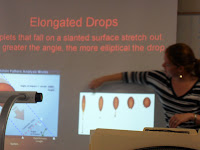2. Reason abstractly and quantitatively. This activity challenged students to find mathematical relationships in real world situations. The students needed to move fluidly between seeing a measurement as the width of the blood droplet to seeing this same distance as the hypotenuse of a right triangle.
3. Construct viable arguments and critique the reasoning of others. By far, the most valuable element of this activity was the opportunity for students to formulate arguments and justify their reasoning using mathematics. This activity did not involve a clean, carefully constructed scenario with a correct "solution." Students differed in which blood droplets they chose to measure. Some students began their measurements from the center of the blood spatter, while others measured from the first droplet. Students used inches, feet, centimeters, meters, and even paces to measure the scene. Together, these variables combined to create enormous variation in student conclusions. Some students pointed the finger at a 5'3" female shooter, while others painted a picture a 6'9" gunman. The key is that each group was able to justify their conclusion using trigonometry (and the debates got fairly heated!). For example, the student work samples below highlight the diversity of student conclusions:
4. Model with mathematics. Students were enthralled by the real world applications of trigonometry. Using publications in forensic science (Jackson & Jackson, 2008), students discovered that the sine function can reveal blood spatter angles. The students were then challenged to find their own trigonometric relationships within the crime scene.
6. Attend to precision. This activity highlighted the importance of precision. Many students carefully measured distances and painstakingly labeled their crime scene map, but neglected to include units of measurement. Partners returned to the classroom to complete their calculations only to discover that "6" might mean feet or inches or centimeters or number of droplets . . . Most students returned to the crime scene multiple times to double check the accuracy of their measurements and to clarify their units.
8. Look for and express regularity in repeated reasoning. Through this activity the students demonstrated increased facility with solving algebraic equations. Initially students worked tediously through trigonometric equations such as tan 41= 5/x by finding tan 41, then writing this decimal as a fraction over 1, then cross multiplying, then dividing both sides by the decimal, and so on. In time, the students created shortcuts for themselves, based on the location of the variable (in the numerator or the denominator) and began to manipulate trig ratios with ease.








No comments:
Post a Comment